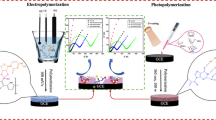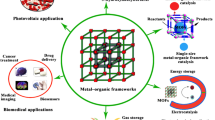Abstract
Herein, a novel notion is used to reuse an expired drug namely Telmisartan (Sensor 2) to optically sense the Fe3+ metal ion. Direct re-usage of the drug avoided wearisome procedures of synthesis, hence proved the method as simple and economic. Sensor 2 found highly stable in the temperature range 25–75 °C. Relative fluorescence was almost the same even after 35 days of observation. There were no significant changes in wavelength even after adding different concentrations of FeCl3, which shows the high stability of the compound. The value of Limit of Detection (LOD) observed was 34.2 nM. FTIR studies confirmed the presence of carboxylic group. The method of fluorescence quenching was used to detect the Fe3+ ion. The association between Sensor 2 and Fe3+ was analyzed using Benesi-Hildebrand relation. Positive deviation from the linearity of S-V plots suggested that the quenching was not purely dynamic. Further, this deviation was analyzed by the sphere of action quenching model. To investigate whether the quenching is diffusion limited, we applied the finite sink approximation model and deduced that quenching is due to both static and dynamic processes. Due to the high fluorescence property of the molecule, it was successfully tested to be used as fluorescent ink.





Similar content being viewed by others
References
Liu W, Diao H, Chang H, Wang H, Li T, Wei W (2017) Sensors and actuators B : chemical green synthesis of carbon dots from rose-heart radish and application for Fe 3 + detection and cell imaging. Sensor Actuat: B Chem 241:190–198. https://doi.org/10.1016/j.snb.2016.10.068
Ding Y, Zhao C (2018) Quim.Nova :a highly selective fluorescent sensor for detection of trivalent metal metal ions based on a simple Schiff-base. Quim Nova 41:623–627. https://doi.org/10.21577/0100-4042.20170229
Kumar J, Bhattacharyya PK, Kumar D (2015) Spectrochimica Acta part a : molecular and biomolecular spectroscopy new duel fluorescent ‘“ on – off ”’ and colorimetric sensor for copper ( II ): copper ( II ) binds through N coordination and pi cation interaction to sensor. Spectrochim Acta A Mol Biomol Spectrosc 138:99–104. https://doi.org/10.1016/j.saa.2014.11.030
Tyagi A, Tripathi KM, Singh N, Choudhary S, Gupta RK (2016) Green synthesis of carbon quantum dots from lemon peel waste: applications in sensing and photocatalysis. RSC Adv 6:72423–72432. https://doi.org/10.1039/C6RA10488F
Cui X, Wang Y, Liu J, Yang Q, Zhang B, Gao Y, Wang Y, Lu G (2017) Sensors and actuators B : chemical dual functional N- and S-co-doped carbon dots as the sensor for temperature and Fe 3 + ions. Sensor Actuat: B Chem 242:1272–1280. https://doi.org/10.1016/j.snb.2016.09.032
Li Z, Li H, Shi C et al (2015) Naked-eye-based highly selective sensing of Fe3+ and further for PPi with nano copolymer film. Sensor Actuat: B Chem. https://doi.org/10.1016/j.snb.2015.11.105
Murugan N, Sundramoorthy KA (2018) Green synthesis of fluorescent carbon dots from Borassus flabellifer flower for label-free highly selective and sensitive detection of Fe3+ ions. New J Chem 42:13297–13307. https://doi.org/10.1039/C8NJ01894D
Societies RC, Federation IP Guidelines for safe disposal of unwanted pharmaceuticals in and after emergencies
Patneedi CB, Prasadu KD (2015) Impact of pharmaceutical wastes on human life and environment. 8:2008–2011
https://pubchem.ncbi.nlm.nih.gov./compound/65999 (accessed 5 December 2019)
Gosse P (2006) A review of telmisartan in the treatment of hypertension : blood pressure control in the early morning hours. Vasc Health Risk Manag 2:195–202
Sharma V, Saini KA, Mobin MS (2016) Multicolour fluorescent carbon nanoparticle probes for live cell imaging cumdual pa.Lladium and mercury sensor. J Mater Chem B 4:2466–2476. https://doi.org/10.1039/C6TB00238B
Sharma V, Kaur N, Tiwari P, Saini AK, Mobin SM (2018) SC. Carbon. 139:393–403. https://doi.org/10.1016/j.carbon.2018.07.004
Song Y, Zhu C, Song J, Li H, du D, Lin Y (2017) Drug-derived bright and color-tunable N-doped CarbonDots for cell imaging and sensitive detection of Fe3+ in living cells. ACS Appl Mater Interfaces 9(8):7399–7405. https://doi.org/10.1021/acsami.6b13954
Pujar MS, Hunagund MS et al (2020) Synthesis of cerium-oxide NPs and their surface morphology effect on biological activities. Bull Mater Sci 43:24. https://doi.org/10.1007/s12034-019-1962-6
Kundu S, Kumari N, Soni SR, Ranjan S, Kumar R, Sharon A, Ghosh A (2018) Enhanced solubility of telmisartan phthalic acid cocrystals within the pH range of a systemic absorption site. ACS Omega 3:15380–15388. https://doi.org/10.1021/acsomega.8b02144
Käppler A, Windrich F, Löder MGJ, Malanin M, Fischer D, Labrenz M, Eichhorn KJ, Voit B (2015) Identification of microplastics by FTIR and Raman microscopy: a novel silicon filter substrate opens the important spectral range below 1300 cm(−1) for FTIR transmission measurements. Anal Bioanal Chem 407:6791–6801. https://doi.org/10.1007/s00216-015-8850-8
Kalsi PS (2004) Spectroscopy of organic compounds. New Age International Publisher, New Delhi
Benesi BA (1949) A spectrophotometric investigation of the interaction of iodine with aromatic hydrocarbons. J. Am. Chem. Soc 71:2832. https://doi.org/10.1021/ja01176a030
Desai VR, Hunagund SM, Pujar MS, Basanagouda M, Kadadevarmath JS, Sidarai AH (2017) Spectroscopic interactions of titanium dioxide nanoparticles with pharmacologically active 3(2H)-pyridazinone derivative. J Mol Liq 233:166–172. https://doi.org/10.1016/j.molliq.2017.03.018
Nagaraja D, Melavanki RM, Patil NR et al (2014) Solvent effect on the relative quantum yield and fl uorescence quenching of a newly synthesized coumarin derivative. https://doi.org/10.1002/bio.2766
Nirupama JM, Khanapurmath NI, Chougala LS, Shastri LA, Bhajantri RF, Kulkarni MV, Kadadevarmath JS (2019) Effect of amino anilines on the fluorescence of coumarin derivative. J Lumin 208:164–173. https://doi.org/10.1016/j.jlumin.2018.12.038
Melavanki RM, Kusanur RA, Kadadevaramath JS, Kulakarni MV (2008) Quenching mechanisms of 5BAMC by aniline in different solvents using stern–Volmer plots. J Lumin 129:1298–1303. https://doi.org/10.1016/j.jlumin.2009.06.011
Patil NR, Melavanki RM, Kapatkar SB, Chandrashekhar K, Patil HD, Umapathy S (2011) Fluorescence quenching of biologically active carboxamide by aniline and carbon tetrachloride in different solvents using stern-Volmer plots. Spectrochimica Acta – Part A: Mol Biomol Spectrosc 79:1985–1991. https://doi.org/10.1016/j.saa.2011.05.104
Patil NR, Melavanki RM, Nagaraja D, Patil HD, Sanningannavar FM, Kapatakar SB (2013) Quenching of the fluorescence of ENCDTTC by aniline and carbon tetrachloride in different organic solvents. J Mol Liq 180:112–120. https://doi.org/10.1016/j.molliq.2013.01.006
Durocher G (1995) Analysis of fluorescence quenching in some antioxidants. 63:75–84
Thipperudrappa J, Hanagodimath SM (2013) Fluorescence quenching of 1, 4-bis [ 2- ( 2-methylphenyl ) ethenyl ] -benzene by aniline in benzene-acetonitrile mixtures [Q]. Int J Life Sci Pharma Res 3:77–87
Kadadevarmath JS, Malimath GH, Melavanki RM, Patil NR (2014) Spectrochimica Acta part a : molecular and biomolecular spectroscopy static and dynamic model fluorescence quenching of laser dye by carbon tetrachloride in binary mixtures. Spectrochim Acta A Mol Biomol Spectrosc 117:630–634. https://doi.org/10.1016/j.saa.2013.08.053
Sidarai AH, Desai VR, Hunagund SM, Basanagouda M, Kadadevarmath JS (2016) Fluorescence quenching of DMB by aniline in benzene – acetonitrile mixture. Int Lett Chem Phys Astron 65:32–36. https://doi.org/10.18052/www.scipress.com/ILCPA.65.32
Hanagodimath SM, Manohara SR, Biradar DS, Hadimani SKB (2008) Fluorescence quenching of 2 ,2″-dimethyl- p -terphenyl by carbon tetrachloride in binary mixtures. Spectrosc Lett 41:242–250. https://doi.org/10.1080/00387010802225567
Edward JT (1970) Molecular volumes and the stokes-Einstein equation. J Chem Educ 47:261–270. https://doi.org/10.1021/ed047p261
https://www.molinspiration.com (accessed 02 October 2019)
Melavanki RM, Patil NR, Sanningannavar FM et al (2013) Solvent effect on fluorescence quenching of biologically active 6-methoxy-4-azidomethyl coumarin by aniline in different solvents. Indian J Pure Appl Phys 51:499–505
Lakowicz JR (1983) Principles of fluorescence spectroscopy. Plenum Press, NewYork
Xu D, Lei F, Chen H, et al (2019) One-step hydrothermal synthesis and optical properties of self-quenching-resistant carbon dots towards fluorescent ink and as nanosensors for Fe3+ detection. RSC Adv 9 8290–8299. https://doi.org/10.1039/c8ra10570g
https://www.bio-rad.com/en-in/product/molecular-imager-gel-doc-xr-system.(accessed 05 June 2020)
Acknowledgements
The authors thank for the financial support by Karnatak University Dharwad, under the scheme of URS (KU/SCH/URS/2018-19/361). Authors are also thankful to The Director and Technical staff of USIC, Dharwad for providing UV-Vis spectrometer, Fluorescence spectrophotometer and TCSPC instrument facilities. Authors oblige DST, New Dehli for providing FTIR spectrometer instrument facility under DST-PURSE-phase-ӏӏ program. [Grant No.SR/PURSE PHASE-2/13(G)] Authors are grateful to Mrs. J.M.Nirupama for guidance throughout the study.
Availability of Data and Material
Not applicable.
Code Availability
Not applicable.
Funding
Present work is supported by funding under the scheme of URS (KU/SCH/URS/2018–19/361).
Author information
Authors and Affiliations
Corresponding author
Ethics declarations
Conflict of Interest
Not applicable.
Additional information
Publisher’s Note
Springer Nature remains neutral with regard to jurisdictional claims in published maps and institutional affiliations.
Rights and permissions
About this article
Cite this article
Nadgir, A., Pujar, M.S., Desai, V.R. et al. Re-usage of the Waste Drug as Molecular Chemosensor for Fe3+ Ion: Application towards Fluorescent Ink. J Fluoresc 30, 1025–1033 (2020). https://doi.org/10.1007/s10895-020-02573-4
Received:
Accepted:
Published:
Issue Date:
DOI: https://doi.org/10.1007/s10895-020-02573-4




